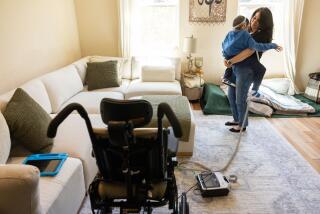Walking Papers for the Walking Wounded
- Share via
Nobody was in the mood for a party.
Even so, a dozen staffers drifted into the empty hospital cafeteria. For two years, their program had helped the walking wounded--older people struggling out of the emotional sinkhole that often opens wide with age.
Now the program at Los Robles Regional Medical Center was dead. The patients had been given a packet of information on possible sources of help around Thousand Oaks but everyone knew it was a sad substitute for the real thing. The shoptalk over paper bowls of chocolate ice cream was subdued.
“I feel like I cast them into a kind of limbo,” a social worker said.
Many people of a certain age are already there. There’s the woman who feels strangely empty after moving across the country to live with her son. There’s the lonely man who stares for hours at a blank TV, the people in pain who have come to see themselves as tattered sacks of symptoms, the ones who feel expelled from the land of the living when they can no longer drive.
These are the people who would spend their days at Los Robles’ partial hospitalization program. They weren’t sick enough for full-time care, but not well enough to glimpse hope without daily help from therapists and daily prodding from each other.
Los Robles closed the program this week. To meet new federal regulations, the hospital would have to hire additional staffers just to deal with paperwork, according to spokeswoman Kris Carraway-Bowman. At the same time, cuts in Medicaid would have meant running the program in the red.
“We’re not pleased about having to do this,” she said. “But the government has got to stop cutting these kinds of programs through Medicare. It’s sinful; it’s really sinful.”
A few of the program’s 22 patients vowed to take matters into their own hands.
Sussette Sidansky wrote letters seeking help from Congress, newspapers, large corporations.
“So many elderly people I know can use a program like this,” she said. “You ask them how they are and they say, ‘Just won-der-ful,’ so sarcastically. Almost every one of them is miserable.”
At 89, Sidanksy has been there. Loathing the prospect of retirement, she worked at a law firm until she was 80. In the years since, she often has felt depressed, isolated, worthless.
“It’s lonely, unless you have a personality that reaches out to people,” she said. “Not many of us do, and even if we once did, we’ve probably lost it.”
Patients faced group-therapy sessions daily--a heavy dose for members of a generation defined by gritty self-reliance. They also did things designed to lure them back to engagement--crafts, poetry, meditation, the friendly banter that some had buried with their best friends.
Eventually, they shed their embarrassment. People who would never think of drawing attention to themselves gladly took their turns blowing bubbles, watching their troubles float away and burst.
At Thursday’s staff gathering, nurses and therapists dug into a couple of gallons of chocolate ice cream as they dealt with their own losses.
“Why chocolate?” a social worker mused. “I can’t eat chocolate.”
“It’s OK,” someone joked. “This will help you separate.”
A goodbye for the patients had been staged earlier in the week.
They exchanged phone numbers and the hugs that had become a program fixture. For some, those embraces had been the only physical contact they had experienced in years, aside from the probings of assorted specialists.
One after the other, each patient released a helium balloon.
“I’m letting go of . . . fear,” a woman proclaimed.
I’m letting go of pain . . . of loneliness . . . of grief, others declared, squinting as the balloons rose into the brilliant blue.
No one expressed the feeling that not long before had been so merciless:
I’m letting go . . . of life.
*
Steve Chawkins can be reached at 653-7561 or at [email protected]
More to Read
Sign up for Essential California
The most important California stories and recommendations in your inbox every morning.
You may occasionally receive promotional content from the Los Angeles Times.











